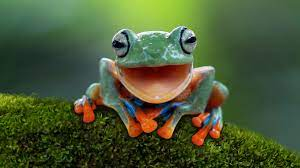Frogs, with their remarkable adaptation as amphibians, lead intriguing lives on both land and in water. These fascinating creatures play vital roles in ecosystems around the world. These are true amphibians, which means they can thrive in both terrestrial and aquatic environments. This dual lifestyle comes with a set of remarkable behaviors.
Life on Land
On land, frogs display various activities:
-
Hunting: Frogs are skilled hunters, relying on their sticky tongues to catch a variety of insects, spiders, and other small invertebrates. They often lie in wait, blending seamlessly with their surroundings before lunging at prey with lightning speed.
-
Burrowing: Some frog species, like the robust burrowing frog, spend much of their lives underground. They create burrows to escape extreme temperatures and predators.
-
Breathing: Although they primarily respire through their skin, frogs have lungs and rely on them when in terrestrial environments. This lung-breathing ability allows them to survive in places with lower oxygen levels.
Life in Water
In aquatic habitats, frogs exhibit a whole different set of behaviors:
-
Breeding: Frogs require water for breeding. They lay eggs in aquatic environments, such as ponds or streams, which hatch into tadpoles. These tadpoles are adapted for underwater life, often having gills to extract oxygen from water.
-
Swimming: As tadpoles, they spend their time swimming and feeding on algae and small plants. Their tails, which are later absorbed during metamorphosis, are perfectly suited for propulsion.
-
Calling: Male frogs are known for their distinctive calls, which they use to attract females during the breeding season. Different frog species have unique calls, ranging from melodious to chirping or croaking sounds.
-
Predation: Frogs are not just hunters; they are also prey. Many animals, including birds, snakes, and larger frogs, feed on them. Their skin's coloration often acts as camouflage against predators.
Habit and Habitat
Frogs are incredibly adaptable and inhabit various environments worldwide:
-
Tropical Rainforests: These lush habitats are home to a rich diversity of frog species. Some frogs here are brilliantly colored, serving as a warning to predators about their toxic skin secretions.
-
Deserts: Even arid deserts are not devoid of frogs. Some species, like the spadefoot toad, have adapted to the harsh conditions by burrowing underground for most of the year and emerging only during rare rainy periods.
-
Ponds and Wetlands: Frogs that depend on water for breeding are commonly found in ponds, marshes, and other wetland areas. These habitats provide a safe space for laying eggs and tadpole development.
-
Tree Dwellers: Tree frogs, like the iconic red-eyed tree frog, inhabit the canopies of tropical forests. Their sticky toe pads enable them to cling to leaves and branches.
Intriguing Characteristics
Beyond their activities and habitats, frogs possess several other captivating traits:
-
Metamorphosis: The transformation from tadpole to frog is one of nature's most astonishing metamorphoses. Tadpoles undergo remarkable changes in body structure, including the development of legs and the loss of gills.
-
Skin Secretions: Many frogs secrete toxic substances through their skin as a defense mechanism. These toxins deter predators, and some are potent enough to be lethal to would-be attackers.
-
Longevity: While some frog species have relatively short lifespans, others can live for several years. The Australian green tree frog, for instance, can live up to 16 years in captivity.
-
Indicator Species: Frogs are considered environmental indicators. Their sensitivity to changes in the environment, especially water quality, makes them valuable indicators of ecosystem health.
-
Cannibalistic Tendencies: Surprisingly, some frog species, especially larger ones, are cannibalistic. They may prey on smaller frogs, including their own species.
Frogs, with their dual life as amphibians, offer us a glimpse into the marvels of adaptation in the natural world. Their incredible activities on land and in water, unique habitats, and intriguing characteristics make them a subject of fascination and study for scientists and nature enthusiasts alike. These remarkable creatures continue to remind us of the richness and complexity of our planet's biodiversity.
